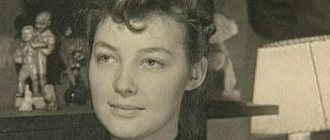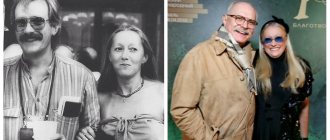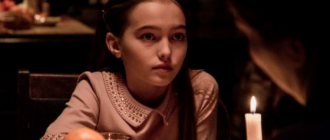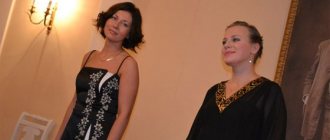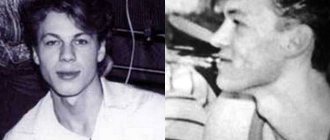Theater student and aspiring actor
Sergei Bondarchuk on the set of his feature film "War and Peace". 1965. Photo: cont.ws
Sergei Bondarchuk was born on September 25, 1920 in the Ukrainian village of Belozerka. His mother Tatyana Bondarchuk worked on a collective farm, and his father Fyodor Bondarchuk was a worker. A few years after the birth of their son, the family moved to Taganrog and then to Yeysk. While still at school, the future director dreamed of becoming an actor and acting in the theater. He attended a drama club and participated in student performances, the first of which was the production of “Jack and the Golden Snuffbox” based on the English fairy tale of the same name.
In 1938, Sergei Bondarchuk graduated from school. His father wanted him to become an engineer, but Bondarchuk decided to enter the theater institute. He went to Moscow and submitted documents to the Moscow Theater School at the Theater of the Revolution (now the Moscow Academic Theater named after Vl. Mayakovsky). He was unable to enroll, but did not return home, but went to Rostov-on-Don. Entrance exams have already ended at the local theater school, but an exception was made for Bondarchuk. He received the highest mark from acting teacher Alexei Maksimov and became a student at the Rostov Theater School. There, the future director studied well and at the same time played in the local theater. Actress Nonna Mordyukova, who was friends with Bondarchuk’s sister, wrote: “We were still at school, and he was already a student at the theater school in Rostov and sent from there photographs in roles. I forgot which ones, but on the cards he always looked handsome, downright stunning.”
Zhenya from Rostov-on-Don
As you know, Bondarchuk was born in Yeisk and studied the basics of acting at the Rostov-on-Don Theater School. There he met Evgenia Belousova, who was a student in the vocal department. This was a beautiful girl from a famous and wealthy family with great connections. When the war began, Sergei and Evgenia traveled together to the fronts and performed concerts in front of the Red Army soldiers. Then Bondarchuk went to fight, but after the victory the young people settled in a luxurious apartment located in the center of Rostov. Their happiness did not last long, and they never formalized their relationship in the registry office.
Sergei Bondarchuk – student of Sergei Gerasimov
Sergei Bondarchuk. Photo: imdb.com
Sergei Bondarchuk (left) with festival guests on the sidelines of the First Moscow International Film Festival. August 3–17, 1959. Moscow. Photo: Georgy Petrusov / Multimedia art museum, Moscow
Sergei Bondarchuk as Othello in the feature film “Othello” by Sergei Yutkevich (1955)
Sergei Bondarchuk did not have time to graduate from theater school - the Great Patriotic War began in 1941, and he was called to the front. He took part in battles in the North Caucasus, received medals and military orders, including “For the Defense of the Caucasus.” After the war, Bondarchuk continued his career in the army, serving near Moscow, but soon decided to return to acting. In 1947, VGIK announced an additional enrollment in the workshop of Sergei Gerasimov and Tamara Makarova. The future director came to the audition and read an excerpt from Nikolai Gogol’s poem “Dead Souls.” For his performance, he received excellent marks from the admissions committee and was enrolled in the third year of the institute.
“He read us Gogol’s “Three Birds” and captivated us with his voice: with tints, with shades. <...> The richness, beauty of intonation and depth of his eyes instantly attracted you to him, it seemed to him that he didn’t need to do or play anything - just say a phrase, look, and you immediately believed him, you fell captive of his personal charm.”
Actress Klara Luchko, “To whom shall we tell my sadness?..” (based on the book “Sergei Bondarchuk. His War and Peace”)
Sergei Bondarchuk was one of the best students on the course. He was often invited to play in student plays and perform at reporting concerts. Screenwriter Vasily Solovyov, who at the same time studied at VGIK, wrote: “The impression was amazing - he did not look like a student. He was a powerful man, although he was only twenty-seven years old.” At the same time, director Sergei Gerasimov decided to film Alexander Fadeev’s novel “The Young Guard”. Bondarchuk was not old enough to play the role of one of the members of the organization of the same name. However, Gerasimov allowed his student to choose any other role in the film.
After The Young Guard, Sergei Bondarchuk began to be invited to the cinema. At first he acted only in episodes, but in 1950 and 1951 he played the main roles in the films “Reider of the Golden Star” and “Taras Shevchenko”. For his second film in 1952, he received the Stalin Prize of the first degree and the title of People's Artist of the USSR. Vasily Lanovoy wrote: “By revealing the image of Taras Grigoryevich Shevchenko on the screen, Bondarchuk declared himself a winner and immediately entered the golden fund of our cinema.”
Over the next few years, Bondarchuk was often given leading roles. In 1955, he played Doctor Dymov in “The Jumper” by Samson Samsonov, a shipbuilder in Friedrich Ermler’s film “The Unfinished Tale” and Othello in the film of the same name by Sergei Yutkevich based on the play by William Shakespeare. The last film brought fame to the artist abroad. “Othello” participated in the main competition program of the Cannes Film Festival and received the prize for best director.
Biography
The future actor and director Sergei Bondarchuk was born in the small Ukrainian village of Belozerka in September 1920.
His youth was spent in Taganrog, where he became so captivated by the magical world of theater and cinema that he even began performing on the stage of the local drama theater. He decided to devote his life to acting, but his father wanted the guy to choose a more serious, “earthly” profession. However, Sergei was adamant in his decision to become an actor.
Such zeal brought yesterday's schoolboy to the walls of the Rostov theater university. However, Sergei did not have time to finish it: the country was on the threshold of the Great Patriotic War. Like many of his peers, Sergei volunteered for the Red Army and served as a soldier throughout the war. Only after graduation he continued his studies by entering the capital’s VGIK in the acting department. In 1948, he graduated with flying colors.
Directorial debut – the film “The Fate of Man”
Sergei Bondarchuk as Andrei Sokolov and Pavel Polunin as Vanyushka in the feature film “The Fate of a Man” by Sergei Bondarchuk (1959)
Filming of Sergei Bondarchuk’s feature film “The Fate of a Man.” 1958. Photograph: Viktor Ruikovich / Multimedia Art Museum, Moscow
Sergei Bondarchuk as Andrei Sokolov in his feature film “The Fate of a Man” (1959)
In 1956, Mikhail Sholokhov published the story “The Fate of a Man” in the Pravda newspaper. Soon Sergei Bondarchuk was invited to voice him for the All-Union Radio program. Sholokhov himself heard the artist’s performance and sent Bondarchuk a telegram in which he wrote: “Now I can’t imagine another artist who could read like that: you read better than I wrote.” At this time, Bondarchuk just decided to try his hand at directing. He looked for a suitable script and ultimately decided to settle on “The Fate of Man.”
“I read [“The Fate of Man”] - and then, no matter what I did, no matter what I thought, I saw only Andrei Sokolov, his little boy, his wife, the flood of the Don, the war, the fascist concentration camp. Making this film became more than a “creative plan” for me. More than a dream. This became the goal of my life"
Sergei Bondarchuk about Mikhail Sholokhov’s story “The Fate of a Man” (according to the magazine “Soviet Screen”, 1987)
Bondarchuk could not obtain permission to film for a long time. The Union of Cinematographers considered him a good actor, but they did not think that he could make a decent film himself. However, the director soon received permission and began filming in July 1958. The film was shot quickly - in just seventy-four days. The main role in “The Fate of Man” was played by Bondarchuk himself. The film was released the following year in 1959 and became very popular. About 40 million people watched it. “The Fate of a Man” received awards at Soviet and international film festivals, including prizes at competitions in Moscow, Melbourne and Sydney. In 1960, Sergei Bondarchuk received the Lenin Prize for this film.
“The first film by Bondarchuk the director received the Lenin Prize. Moreover, "The Fate of Man" stunned the whole world. <…> Bondarchuk in his film answered the questions: why and how we won. But for me, who went through the front and then spent two years in hospitals, “The Fate of a Man” is dear because it clearly shows: the Patriotic War was a people’s war, which was won by both the front and the rear. <...> Here it seems to be the fate of one person, but the content of this person’s life, this national character, is comprehensive.”
Screenwriter Vasily Solovyov, “War and Peace” and Us” (based on the book “Sergei Bondarchuk. His War and Peace”)
Mikhalkov-Konchalovsky - directors and actors
Actress Lyubov Tolkalina (left), film director Yegor Konchalovsky and their daughter Maria.
Photo: Frolov Mikhail Sergei Mikhalkov was a legendary Soviet poet who wrote the Anthem of the Soviet Union and many children's poems (about Uncle Styopa, for example). His children - masters of Russian cinema Nikita Mikhalkov and Andrei Konchalovsky (took his mother's last name) - do not need a detailed introduction, everyone knows them.
Directed by Nikita Mikhalkov. Photo: KP/Mila Strizh
Yegor Konchalovsky is the grandson of the poet Sergei Mikhalkov, the son of director Andrei Konchalovsky. He followed in the footsteps of his father, his main activity is directing, he made films such as “Antikiller”, “Escape”, “Canned Food”, “My Heart is Astana”, and others.
Nikita Mikhalkov’s children also continued their father’s profession. His daughters Anna and Nadezhda are sought-after actresses; his son Artem chose to work as a screenwriter and director.
more on the topic
Yulia Vysotskaya: “I sleep in a cold room and douse myself with ice water” Popular actress and TV presenter - about New Year traditions, delicious recipes and beauty secrets
Oscar-winning director - the epic “War and Peace”
Sergei Bondarchuk on the set of his feature film "War and Peace". 1964. Photo: yablor.ru
Filming of the Battle of Borodino in Sergei Bondarchuk’s feature film “War and Peace.” 1963. Photo: yablor.ru
Sergei Bondarchuk (second from right) on the set of his feature film “War and Peace.” Photo: museikino.ru
Soon after the success of “The Fate of Man,” USSR Minister of Culture Ekaterina Furtseva invited Sergei Bondarchuk and Ivan Pyryev to film Leo Tolstoy’s epic novel “War and Peace.” Ivan Pyryev refused to shoot the film. And Bondarchuk postponed work on the film adaptation of Chekhov’s story “The Steppe” for the sake of this film.
Bondarchuk wrote the script for the epic together with Vasily Solovyov. The director said: “We need everyone to understand that we don’t want to show ourselves with the help of Tolstoy, but with the help of cinema we want to express the unique thing that Tolstoy discovered in literature.”
The director spent a long time selecting actors for the film, turned down famous artists and arranged lengthy auditions. To find a performer for the role of Natasha Rostova, he even published an advertisement in the newspapers. However, screenwriter Vasily Solovyov noticed a suitable candidate at the Leningrad Ballet School, and Lyudmila Savelyeva was approved for the role. Sergei Bondarchuk himself played Pierre Bezukhov in War and Peace. Vasily Solovyov recalled: “Sergei was convinced that Pierre was the painting. He is its sound. Tolstoy’s entire understanding of both life and God comes through Pierre. <…> As a result, he had to play Pierre himself and read Tolstoy’s text “from the author” .
Bondarchuk worked very carefully on the film adaptation: he traveled to Yasnaya Polyana several times, studied Tolstoy’s manuscripts, consulted with scientists in order to accurately reproduce the outfits, uniforms of the troops, and the furnishings of the estates. The film adaptation used both original objects from the early 19th century and copies that were made specifically for the film.
Filming of Sergei Bondarchuk's feature film "War and Peace". Photo: pastvu.com
Sergei Bondarchuk as Pierre Bezukhov and Vyacheslav Tikhonov as Andrei Bolkonsky in Sergei Bondarchuk's feature film "War and Peace" (1965–1967)
From left to right: actresses Lyudmila Savelyeva and Irina Gubanova and Sergei Bondarchuk on the set of Sergei Bondarchuk’s feature film “War and Peace.” Photo: interest.pics
Filming of the epic lasted about six years. A separate cinematic cavalry regiment was created especially for the film. About one hundred thousand soldiers took part in the scenes of the Shengraben, Austerlitz and Borodino battles, among whom were one and a half thousand horsemen. Over five hundred thousand blank cartridges were produced for the episodes.
“Plants, factories and workshops throughout the Soviet Union participated in the creation of all these historical costumes, military equipment, equipment and props. Our entire, then huge, indestructible country worked with skill and inspiration for the film epic “War and Peace”
Director of the film “War and Peace” Nikolai Ivanov (based on the book “Sergei Bondarchuk. His War and Peace”)
Sergei Bondarchuk spent a long time looking for a composer for the film. Aram Khachaturian, Dmitry Shostakovich and Georgy Sviridov applied for this place, but the director chose conservatory student Vyacheslav Ovchinnikov. Vasily Solovyov wrote: “A composer, as a rule, appears on a film when a significant part has been filmed, looks at the material, and, in accordance with what he sees, writes music. In our case, on the contrary, Bondarchuk filmed some episodes to music composed by Ovchinnikov.”
Filming was difficult for Bondarchuk; he even experienced clinical death from stress. The management of Mosfilm demanded that the first episode be urgently prepared in order to show it at the 1965 Moscow International Film Festival. The film crew had to stop working on the film and start editing and dubbing. During the process, Bondarchuk’s heart stopped; doctors barely saved him.
The first episode of the epic was released in 1966 and became a box office leader. The next three parts of War and Peace were shown in 1967. The film was very popular. The four episodes of the epic were collectively watched by over 135 million viewers. The film won recognition abroad as well. “War and Peace” received several prestigious awards, including an Oscar, a Golden Globe and the US National Board of Film Critics Award for Best Foreign Language Film.
Meeting with Bondarchuk Sr.
While the boy was growing up, Inna Makarova kept in touch with him. This was not even prevented by the fact that the actress and director divorced in 1959. The master’s new wife, Irina Skobtseva, did not encourage her husband’s relationship with his former family. Even Natalya Bondarchuk (daughter of Sergei Fedorovich and Inna Makarova) saw her father extremely rarely, although she lived in the same city with him. Perhaps she did not know about the existence of Alexei Bondarchuk. At least, members of the film crew of the film “War and Peace” claimed that the appearance of the guy was a real surprise for her. And the father did not immediately recognize his first-born. He even first demanded that the stranger be taken away from the set, and was confused when he realized that in front of him was Alexey Bondarchuk.
The conversation between the star father and son did not go well. The dejected young man returned to Makarova’s apartment, where he stayed a couple of times when he came to the capital. Nevertheless, Bondarchuk Sr. issued his son a pass to the set so that they had the opportunity to communicate.
Subsequently, the man complained to Makarova that the guy was behaving obscenely and harassing actresses. In response, she asked him: “Who was supposed to raise him?”, thereby reproaching him for the lack of proper attention to children born before his marriage to Skobtseva.
“Good creative comrade”: films of the 1970s and 1980s
Sergei Bondarchuk (left) with his wife Irina Skobtseva with VGIK students. 1962. Moscow. Photo: Sergey Vasin / Multimedia art museum, Moscow
Actor Evgeny Samoilov (left) and Sergei Bondarchuk (second from right). 1960s Moscow. Photo: Pavel Manych / Multimedia art museum, Moscow
Sergei Bondarchuk and actress Irina Korotkova on the set of Yulia Solntseva’s feature film “Such High Mountains.” 1974. Novgorod-Seversky, Chernigov region, Ukrainian SSR. Photo: family archive of Maria Kosareva / russiainphoto.ru
In 1969, Italian producer Dino De Laurentiis invited Sergei Bondarchuk to make a historical film about Napoleon together. Its theme was the Battle of Waterloo in 1815. Bondarchuk agreed and wrote the script for the film that same year. Together with Laurentiis, he managed to attract famous actors from the USA, Canada, Italy and the USSR to work on the film, including Rod Steiger, Christopher Plummer, Andrea Cecchi and Evgeny Samoilov.
“When working with actors, director Sergei Bondarchuk is a good creative comrade. A brilliant artist himself, he never divided the actors into main and secondary ones, he was equally attentive to everyone: it doesn’t matter whether you are the main character or playing an episode with one line. <...> It was gratifying to observe with what genuine interest and respect such great masters of world cinema as Rod Steiger, Orson Welles, Christopher Plummer, who starred in the film “Waterloo,” listened to his remarks.”
Evgeny Samoilov, “Nutryak” (based on the book “Sergei Bondarchuk. His War and Peace”)
Despite Bondarchuk's efforts, the film failed at the box office. But the director did not give up creativity. Over the next five years, he acted a lot - he played leading roles in the films “Such High Mountains” and “Choosing a Target.” During these same years, Bondarchuk became a professor at VGIK and secretary of the board of the Union of Cinematographers of the USSR.
In 1975, Sergei Bondarchuk returned to directing and filmed Mikhail Sholokhov’s novel “They Fought for the Motherland.” The main roles in the film were played by Vasily Shukshin and Vyacheslav Tikhonov. Actress Zinaida Kiriyenko wrote: “In my opinion, he passed this Sholokhov novel through his heart, through his worldview and assembled wonderful actors, all real guys, very reliable.” Right during filming, Vasily Shukshin died and in the remaining scenes with the participation of his hero it was necessary to use another actor - Yuri Solovyov, and then re-voice all his lines. The music for the film was again composed by composer Vyacheslav Ovchinnikov at the invitation of Bondarchuk. The film became one of the most popular in 1976, the film was awarded the State Prize of the RSFSR.
Still from Sergei Bondarchuk’s feature film “They Fought for the Motherland” (1975)
Cameraman Vadim Yusov and Sergei Bondarchuk (right) on the set of Sergei Bondarchuk’s feature film “Red Bells”. 1981. Photo: m24.ru
Delegates of the Third Congress of the Union of Cinematographers of the USSR Mark Donskoy and Sergei Bondarchuk (right). May 11–13, 1976. Moscow. Photo: Yuri Sadovnikov / Multimedia art museum, Moscow
The following year, 1977, Bondarchuk returned to the film adaptation of Chekhov's story "The Steppe", in which he played the main role - the singer Emelyan. He took a break from directing for several years and focused on acting - he starred in the films “The Velvet Season” and “The Gadfly.” In 1981, the first part of the director’s new epic, the film “Red Bells,” entitled “Mexico on Fire,” was released, and in 1982, its sequel, “I Saw the Birth of a New World,” was released. Bondarchuk decided to film the collections of reports by the American writer John Reed, “Mexico Rising” and “Ten Days That Shook the World.” They were dedicated to two revolutions - Mexican and Russian. For “Red Bells” Bondarchuk received the USSR State Prize.
In 1986, the director filmed the tragedy of Alexander Pushkin “Boris Godunov”, in which he played the main role. The artist Alexander Shilov wrote: “I believe that he played the tragedy of Tsar Boris primarily with his own eyes. The depth in his eyes is bottomless." The image of Boris Godunov was one of Bondarchuk’s favorites. He dreamed of playing this character for many years and prepared a lot for the role.
“They said that he spent the whole day preparing for Tsar Boris’s monologue on the Godunov. And anyone who tried to come up, ask about the props, or clarify the schedule for the next day of filming, received such a rebuff that he was afraid to show up all day. Although it was his responsibility as director to answer production questions. But he was in character! He strictly demanded understanding. And this is not the actor’s egoism and not a manifestation of his cool character. Sergei Fedorovich treated the work of an actor with reverent exactingness.”
Actor Andrei Rostotsky, “Candle” (based on the book “Sergei Bondarchuk. His War and Peace”)
The film “Boris Godunov” was Bondarchuk’s last directorial work, which was released during his lifetime.
Directing activity
Sergei Fedorovich received his first directorial experience in 1959, when he directed the dramatic film “The Fate of a Man.” In addition, Sergei Bondarchuk played a central role in it. The film turned out to be incredibly touching: it touched the heartstrings of millions of people who survived the horrors of war.
It is not surprising that he received many prizes and awards, including the honorary Lenin Prize.
Subsequently, Sergei Bondarchuk repeatedly played significant roles in his film works. He very talentedly brought to the screens the image of Pierre Bezukhov in his epic film “War and Peace”. The film adaptation of the work of the same name by the Russian classic caused a real sensation not only in the Soviet Union, but throughout the world.
For his work, to which Bondarchuk devoted six years, he was awarded many film awards, as well as an Oscar and a diploma from the Venice Film Festival. The film “War and Peace” won the love of viewers all over the world, because it was released in more than a hundred countries.
In 1975, the director shot another film masterpiece - the dramatic war film “They Fought for the Motherland.” He managed to convey the full tragedy of the retreat of the Soviet army, which was not to the liking of many film industry officials. However, this did not prevent the film from receiving audience recognition and honorary film awards.
In the film "Waterloo" the director was able to consolidate his success as a master of staging impressive battle scenes , which were successfully intertwined with the difficult destinies of the main characters. This was followed by equally successful works by Bondarchuk: a film adaptation of Chekhov’s story “The Steppe” and the film “Red Bells,” based on the works of John Reed.
| Year | Movie |
| 1959 | Man's destiny |
| 1965-1966 | War and Peace |
| 1970 | Waterloo (Italy, USSR) |
| 1975 | They fought for their homeland |
| 1977 | Steppe |
| 1981 | Red bells. Film 1. Mexico on Fire (USSR, Italy, Mexico) |
| 1982 | Red bells. Film 2. I saw the birth of a new world (USSR, Italy, Mexico) |
| 1986 | Boris Godunov (USSR, Czechoslovakia, East Germany, Poland) |
| 1992 | Quiet Don (Great Britain, Italy, Russia) |
The last work of the outstanding director was the 8-episode epic film “Quiet Flows the Flow of the Don”, but he never saw it released.
Personal life
Sergei Bondarchuk’s second wife, Inna Makarova (left), on the set of Sergei Gerasimov’s feature film “The Young Guard.” 1948. Photo: molodguard.ru
Sergei Bondarchuk as Othello and Irina Skobtseva as Desdemona in the feature film Othello by Sergei Yutkevich (1955)
Sergei Bondarchuk with his wife Irina Skobtseva. 1960s. Photo: Oleg Mertsedin / Multimedia art museum, Moscow
Sergei Bondarchuk was married three times. His first wife was Evgenia Belousova, whom the director met while studying at the Rostov Theater School. They separated after the war, when Bondarchuk went to enroll in a theater institute in Moscow. The marriage produced a son, Alexey.
The second wife of Sergei Bondarchuk was a classmate in Gerasimov’s workshop at VGIK, Inna Makarova. They married while filming The Young Guard in 1947. The actress recalled: “With him, I felt like a foolish girl - after all, when we got married, Sergei was already a grown man, who had gone through the front, who had once been married.” In 1950, Sergei Bondarchuk and Inna Makarova had a daughter, Natalya. The director and actress separated in 1958 during the filming of My Dear Man in 1958.
A year later, Bondarchuk married for the third time. His wife was actress Irina Skobtseva. They met on the set of the film Othello. In the film, Bondarchuk played Othello, and Skobtseva played Desdemona. They lived together for more than thirty years. Bondarchuk often featured his wife in his films, including War and Peace. Actress Klara Luchko wrote: “She was his inspiration, his muse. And these are not nice words. We, close friends, always noted how united they are, how they breathe the same air.” Their family had two children - daughter Alena and son Fedor. Alena Bondarchuk was a theater and film artist, and Fedor, in addition to acting, was involved in directing.
Personal life and children
As for his personal life, everything is smooth here. Sergei had no stormy romances. He married Tatiana Mamiashvili early. Tatiana (Tata) is the daughter of the famous athlete, Olympic champion in wrestling, Mikhail Mamiashvili. She graduated from MGIMO with a degree in Journalism.
In 2012, the young people got married; Bondarchuk Jr. was then barely 20, and his bride was 22 years old. The wedding was luxurious - the parents did their best. Among the guests were stars of Russian show business and politics. Alexander Tkachev (governor of the Krasnodar region), Pavel Lungin, Valentin Yudashkin, Alika Smekhova, Joseph Kobzon, and many others. Tatiana's dress caused admiration and applause - it was sewn according to the sketches of Hollywood designers.
Friends and colleagues of Sergei Bondarchuk Jr. were unanimous in the opinion that since his friend started a family and children, his character has changed positively. He became calmer, more intelligent, even wiser. The actor himself claimed that his wife Tatiana was his real support, support, closest friend, and not just his beloved woman. Tata admitted that in life Sergei is stern and serious, but in the family circle he is very cheerful, kind, and gentle.
Despite the early marriage, the family seemed strong. Sergei Bondarchuk Jr. and Tatiana are raising two daughters – Margarita and Vera. After 7 years, the couple divorces.
This is interesting! After 20 years of marriage, Fedor and Svetlana Bondarchuk divorced. There is currently a lawsuit going on regarding the division of property.
Now he is actively involved in business, supports his sister Varya, who suffers from cerebral palsy, and maintains a warm relationship with his ex-wife. Sergei loves his fans, and constantly posts photos on his Instagram, which cannot but please admirers of his work.
Recent years: “Quiet Don”
Still from Sergei Bondarchuk’s feature film “Quiet Don” (2006)
In 1986, the leadership of the Union of Cinematographers was re-elected. Sergei Bondarchuk was not included in the updated composition. His work began to be criticized in the Soviet press, and no money was allocated for new projects. Since the mid-1980s, Bondarchuk has been working on a film adaptation of Mikhail Sholokhov's novel Quiet Don. He wanted to start filming the epic in 1986, but did not receive funds from Goskino.
“In the initial times of perestroika, there was not a single article in the press about cinema that did not vilify Bondarchuk. He wasn’t even chosen as a delegate to the USSR Cinematographers’ Congress. <...> The perestroika “wind of change” slammed the film “Quiet Don” for him, which he was supposed to make for television. <...> He wrote a script for 20 episodes, they said they needed 18 - he rewrote it, then they asked to leave 16 - again he rewrote everything completely. When it came to 13 episodes, he was told: the money allocated for “Quiet Don” would be better spent on agriculture.”
Directed by Georgy Danelia, “My Bondarchuk” (based on the book “Sergei Bondarchuk. His War and Peace”)
In 1990, Bondarchuk signed a contract with the Italian company International Cinema Company and began filming Quiet Don. The director invited English actor Rupert Everett to play the role of Grigory Melekhov, and Bondarchuk’s daughter Alena played Natalya Melekhova, his wife. “Quiet Don” was filmed in eleven months - by August 1992 it was ready. Editing and dubbing of the film began, but at the same time the Italian company declared itself bankrupt, and all the materials of the film were seized by the creditor bank. Work on “Quiet Don” stopped, and Bondarchuk began to have serious health problems. The director never saw Quiet Don in theaters. He died on October 20, 1994 in Moscow. The cause of death was serious illness. Sergei Bondarchuk was buried at the Novodevichy cemetery.
“Quiet Don” was completed by Fyodor Bondarchuk twelve years after his father’s death. A seven-part television film was released in 2006.
Latest news about Sergei Bondarchuk
Bondarchuk Sr. never managed to finish his last project. In 1990, the author of “Quiet Don” signed a contract with Italian producers. When the budget was exhausted, foreign colleagues refused to continue working on the film. The editing stage was taken over by the director's son Fyodor Bondarchuk. The matter was successfully completed.
The premiere screening of the drama based on the novel of the same name by M. Sholokhov took place on November 6, 2006. According to the author’s idea, there should have been 10 episodes, but Fedor aired only 7. After some time, the updated version of “Quiet Don” was voiced for rental in European countries.
